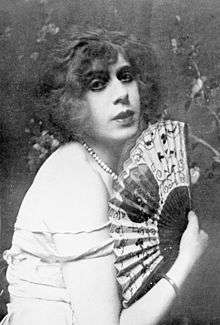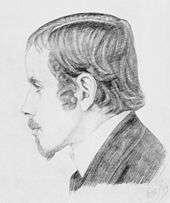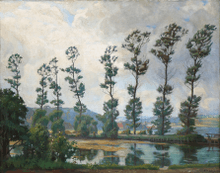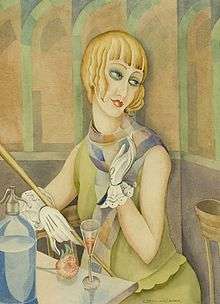Lili Elbe
| Lili Elbe | |
|---|---|
 Lili Elbe in 1926 | |
| Born |
Einar Magnus Andreas Wegener 28 December 1882 Vejle, Denmark |
| Died |
13 September 1931 (aged 48) Dresden, Germany |
| Nationality | Danish |
| Other names | Lili Ilse Elvenes |
Lili Ilse Elvenes (28 December 1882 – 13 September 1931), better known as Lili Elbe, was a Danish transgender woman and one of the first identifiable recipients of sex reassignment surgery.[1][2] Elbe was born Einar Magnus Andreas Wegener[3] and was a successful painter under that name. During this time she also presented as Lili (sometimes spelled Lily) and was publicly introduced as Einar's sister. After successfully transitioning in 1930, she changed her legal name to Lili Ilse Elvenes and stopped painting altogether.[4] The name Lili Elbe was given to her by Copenhagen journalist Louise Lassen.[5] She died from complications involving a uterus transplant.[6][7][8] Her autobiography, Man into Woman, was posthumously published in 1933.[9]
Early life
It is generally believed that Elbe was born in 1882, in Vejle, Denmark. Her year of birth is sometimes stated as 1886, which appears to be from a book about her which has some facts changed to protect the identities of the persons involved. Facts about the life of Elbe's wife Gerda Gottlieb suggest that the 1882 date is correct, as they married while at college in 1904, when she would have been just eighteen if the 1886 date were correct.[10][11]
It is speculated that Elbe was intersex,[12][13][14][15] although that has been disputed.[16] Some reports indicate that she already had rudimentary ovaries in her abdomen and she may have had Klinefelter syndrome.[6][17]
Marriage and modelling


Elbe met Gerda Gottlieb while they were students at the Royal Danish Academy of Fine Arts in Copenhagen,[18] and they married in 1904, when Gottlieb was 19 and Elbe was 22.[10] They worked as illustrators, with Elbe specializing in landscape paintings, while Gottlieb illustrated books and fashion magazines. They traveled through Italy and France, eventually settling in Paris in 1912, where Elbe could live openly as a woman, and Gottlieb identified as lesbian.[10] Elbe received the Neuhausens prize in 1907 and exhibited at Kunstnernes Efterårsudstilling (the Artists' Fall Exhibition), at the Vejle Art Museum, and in the Saloon and Salon d'Automme in Paris. She is represented at Vejle Art Museum in Denmark.[19]
Elbe started dressing in women's clothes after filling in for Gottlieb's absentee model; she was asked to wear stockings and heels so her legs could substitute for those of the model. Elbe felt surprisingly comfortable in the clothing and began identifying as a woman.[19] Over time, Gottlieb became famous for her paintings of beautiful women with haunting, almond-shaped eyes dressed in chic fashions. In 1913, the unsuspecting public was shocked to discover that the model who had inspired Gottlieb's depictions of petites femmes fatales was in fact Elbe.[10]
In the 1920s and 1930s, Elbe regularly presented as a woman, attending various festivities and entertaining guests in her house. One of the things she liked to do was disappear into the streets of Paris in the throngs of revelers during the Carnival, wearing her modeling fashions.[20][21] Elbe was sometimes introduced by Gottlieb as her own sister when she was dressed in female attire.[2] Only her closest friends knew once she had transitioned.
Surgeries and dissolution of marriage

In 1930, Elbe went to Germany for sex reassignment surgery, which was highly experimental at the time. A series of four operations were carried out over a period of two years.[21] The first surgery, removal of the testicles, was made under the supervision of sexologist Magnus Hirschfeld in Berlin.[21] The rest of Elbe's surgeries were carried out by Kurt Warnekros, a doctor at the Dresden Municipal Women's Clinic.[22] The second operation was to implant an ovary onto her abdominal musculature, the third to remove the penis and the scrotum,[23] and the fourth to transplant a uterus and construct a vaginal canal.[6][24]
At the time of Elbe's last surgery, her case was already a sensation in newspapers of Denmark and Germany. A Danish court invalidated the couple's marriage in October 1930,[25] and Elbe managed to get her sex and name legally changed, including receiving a passport as Lili Ilse Elvenes. She stopped painting, believing it to be something that was part of the identity of Einar. After the dissolution of their marriage, Elbe returned to Dresden for her fourth surgery.
Elbe became the second transgender woman to undergo Gohrbandt's vaginoplasty technique in 1931, after Dora Richter underwent the same procedure.[5] Her castration and penectomy had been performed by Dr. Ludwig Levy-Lenz (1889–1966) the previous year. These preliminaries have sometimes caused confusion over the date of her reassignment surgery.[5] Gohrbandt's surgery deliberately left remnants of the scrotum intact, with a view to modifying these into labia at a later date, but for reasons that are unclear, he did not perform this further procedure himself. Instead, Elvenes' case was taken over by Dr. Kurt Warnekros (1882–1949), at the Dresden Women's Clinic. Here, the labiaplasty and a subsequent surgical revision led, in the pre-antibiotic age, to Elbe's death from infection in September 1931.[5]
The ritual book-burning at the Institute for Sexual Research by Nazi students in May 1933, the obliteration of the Dresden Women's Clinic and its records in the Allied bombing raids of February 1945, and the myth-making process itself have left gaps and inconsistencies in the Lili Elbe narrative that may never be resolved.[5]
Death

Elbe began a relationship with French art dealer Claude Lejeune, whom she wanted to marry and with whom she wanted to have children. She was looking forward to her final surgery involving a uterus transplant.[7][8][24]
In June 1931, Elbe had an operation which consisted of implanting a uterus and the construction of a vagina, both of which were new and experimental procedures at that time.[6] Her immune system rejected the transplanted uterus, however, and she developed an infection. She died on September 13, 1931, three months after the surgery, of cardiac arrest brought on by the infection.[6][7][8][24][26]
Elbe was buried on Trinitatisfriedhof in Dresden. The grave was levelled in the 1960s. In April 2016, a new tombstone was inaugurated, financed by Focus Features, the production company of The Danish Girl.[27][28]
In popular culture
The LGBT film festival MIX Copenhagen gives four "Lili" awards named after Elbe.[29]
In 2000, David Ebershoff wrote The Danish Girl, a fictionalized account of Elbe's life.[30] It was an international bestseller and was translated into a dozen languages. In 2015, it was made into a film, also called The Danish Girl, produced by Gail Mutrux and Neil LaBute and starring Eddie Redmayne as Elbe. The film was well received at the Venice Film Festival in September 2015,[31] although it has been criticized for its casting of a cisgender man to play a transgender woman.[32] Both the novel and the film omitted topics including Gottlieb's sexuality, which is evidenced by the subjects in her erotic drawings,[33] and the disintegration of Gottlieb and Elbe's relationship after their annulment.[34]
References
- ↑ Hirschfeld, Magnus. Chirurgische Eingriffe bei Anomalien des Sexuallebens: Therapie der Gegenwart, pp. 67, 451–455
- 1 2 Lili Elbe. andrejkoymasky.com. 17 May 2003
- ↑ Meyer, Sabine (2015), »Wie Lili zu einem richtigen Mädchen wurde« – Lili Elbe: Zur Konstruktion von Geschlecht und Identität zwischen Medialisierung, Regulierung und Subjektivierung, p. 15, pp. 312–313.
- ↑ (Meyer 2015, pp. 311–314)
- 1 2 3 4 5 "A Trans Timeline – Trans Media Watch". Trans Media Watch. Retrieved February 3, 2016.
- 1 2 3 4 5 "Lili Elbe Biography". Biography.com. A&E Television Networks. Retrieved December 11, 2015.
- 1 2 3 "Lili Elbe: the transgender artist behind The Danish Girl". This Week Magazine. 18 September 2015. Retrieved 1 February 2016.
- 1 2 3 "The Danish Girl (2015)". HistoryVSHollywood.com. History vs Hollywood. Retrieved 1 February 2016.
- ↑ Worthen, Meredith (n.d.). "Lili Elbe – Painter". Biography.com. Retrieved August 15, 2016.
- 1 2 3 4 She and She: The Marriage of Gerda and Einar Wegener. The Copenhagen Post. 3 July 2000
- ↑ "Ejner Mogens Wegener, 28-12-1882, Vejle Stillinger: Maler". Politietsregisterblade.dk. Retrieved 30 December 2011.
- ↑ Hoyer, ed., Niels (2004). Man into woman : the first sex change, a portrait of Lili Elbe : the true and remarkable transformation of the painter Einar Wegener. London: Blue Boat Books. pp. vii, 26–27, 172. ISBN 9780954707200.
- ↑ "Lili Elbe's autobiography, Man into Woman". OII Australia – Intersex Australia. OII Australia. Retrieved 1 September 2015.
- ↑ Vacco, Patrick (29 April 2014). "Les Miserables Actor Eddie Redmayne to Star as Queer Artist Lili Elbe". The Advocate. Retrieved 1 September 2015.
- ↑ "Could this be Eddie Redmayne's most challenging role?". Daily Mail. 1 September 2015. Retrieved 1 September 2015.
- ↑ Kaufmann, Jodi (January 2007). "Transfiguration: a narrative analysis of male‐to‐female transsexual". International Journal of Qualitative Studies in Education. 20 (1): 1–13. doi:10.1080/09518390600923768.
- ↑ "Matt & Andrej Koymasky - Famous GLTB – Lili Elbe". HistoryVSHollywood.com. Matt & Andrej Koymasky. 17 May 2003. Retrieved 2 February 2016.
- ↑ "Conway's Vintage Treasures". Vintage-movie-poster.com. Retrieved 8 April 2014.
- 1 2 The Arts and Transgender. renaissanceblackpool.org
- ↑ Gerda Wegener. get2net.dk
- 1 2 3 "Lili Elbe (1886–1931)". LGBT History Month. Retrieved 8 April 2014.
- ↑ Brown, Kay (1997) Lili Elbe. Transhistory.net.
- ↑ (Meyer 2015, pp. 271–281)
- 1 2 3 Harrod, Horatia (8 December 2015). "The tragic true story behind The Danish Girl". The Telegraph. Retrieved 11 December 2015.
- ↑ (Meyer 2015, pp. 308–311)
- ↑ "Lili Elbe (Einar Wegener) 1882–1931". Danmarkshistorien.dk (in Danish). Danmarkshistorien.dk. 10 September 2013. Retrieved 2 February 2016.
- ↑ http://www.queer.de/bild-des-tages.php?einzel=1485
- ↑ Haufe, Kay (22 April 2016). "Hollywood rettet Lili Elbes Grab" [Hollywood saves Lili Elbe's grave]. Sächsische Zeitung (in German). Retrieved 26 April 2016.
- ↑ "In Competition". MIX Copenhagen. Retrieved March 5, 2015.
- ↑ "BOOKS OF THE TIMES; Radical Change and Enduring Love". The New York Times. February 14, 2000. Retrieved December 11, 2015.
- ↑ "'The Danish Girl' Wows With 10-Minute Standing Ovation In Venice Premiere". Deadline. 5 September 2015. Retrieved 6 September 2015.
- ↑ Denham, Jess (12 August 2015). "The Danish Girl: Eddie Redmayne defends casting as trans artist Lili Elbe after backlash". The Independent. Retrieved 7 March 2016.
- ↑ "The Incredibly True Adventures of Gerda Wegener and Lili Elbe". coilhouse.net. August 3, 2012. Retrieved January 26, 2016.
- ↑ "Reading Group Notes The Danish Girl". allenandunwin.com. Retrieved December 10, 2015.
Further reading
- Man into woman: an authentic record of a change of sex / Lili Elbe ; edited by Niels Hoyer [i.e. E. Harthern] ; translated from the German by H.J. Stenning ; introd. by Norman Haire. – London, Jarrold Publisher's, 1933 (Original Danish ed. published in 1931 under title: Fra mand til kvinde. Later edition: Man into woman: the first sex change, a portrait of Lili Elbe – the true and remarkable transformation of the painter Einar Wegener. - London, Blue Boat Books, 2004.
- Schnittmuster des Geschlechts. Transvestitismus und Transsexualität in der frühen Sexualwissenschaft by Dr. Rainer Herrn (2005), pp. 204–211. ISBN 3-89806-463-8. German study containing a detailed account of the operations of Lili Elbe, their preparations and the role of Magnus Hirschfeld.
- »Wie Lili zu einem richtigen Mädchen wurde« – Lili Elbe: Zur Konstruktion von Geschlecht und Identität zwischen Medialisierung, Regulierung und Subjektivierung by Sabine Meyer (2015), ISBN 978-3-8376-3180-7.
- "When a woman paints women" / Andrea Rygg Karberg and "The transwoman as model and co-creator: resistance and becoming in the back-turning Lili Elbe" / Tobias Raun in Gerda Wegener / edited by Andrea Rygg Karberg ... [et al.]. – Denmark, Arken Museum of Modern Art, 2015.
External links
| Wikimedia Commons has media related to Lili Elbe. |
- Lili Elbe on Biography.com
- Lili Elbe on LGBT History Month
- Sabine Meyer: Mit dem Puppenwagen in die normative Weiblichkeit. Lili Elbe und die journalistische Inszenierung von Transsexualität in Dänemark. In: NORDEUROPAforum 20 (2010:1–2), 33–61. Article in German scholarly journal
- Represented in ARKEN Museum of Modern Art's Gerda Wegener exhibition 7. November 2015 til 8. January 2017